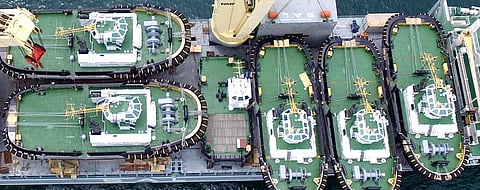

With the notable exception of the offshore service vessel sector, 2017 turned out to be an exciting year of great progress, both technically and operationally, for much of the global workboat industry.
Apart from the practically – but temporarily – moribund OSV sector, numerous very impressive new vessels have been delivered to most other sectors of the industry. They have been reviewed, month-by-month, in Work Boat World and the best of them summarised on the following pages [see the January issue of Work Boat World].
Ferries, tourist boats, tugs and wind farm support vessels have been particularly active. Almost all are more capable, efficient and economical than those they replace. Fishing and aquaculture boats have experienced a sectoral spurt with boats getting bigger, better and more efficient. The same applies to their environmental sustainability characteristics.
Fine Australian ferries
I spent the three days before writing this racing a wonderful classic yacht on Sydney Harbour. Whenever I was not concentrating on that, I watched the commercial traffic carefully. While few tugs now operate on the harbour, there are more ferries than ever.
Almost all are impressively efficient. They race around at high speeds, slicing through the water with minimal wake and a very comfortable motion. They can stop quickly and without drama so are ideal for a very crowded waterway. They are notably more fuel-efficient than the vessels they replaced. They are exceptionally safe vessels in both the primary and secondary senses of that word.
As examples of modern naval architecture and shipbuilding, they are incomparably more impressive than the current crop of motor yachts you see there. To me, those ferries represent all the most exciting qualities of the modern workboat industry.
Practically all the new Sydney harbour ferries have been built for their various owners by Tasmanian shipbuilders Incat and Richardson Devine Marine. Sydney Harbour is now, at last, a fine showcase for their collective talents.
World tour
As I age, I travel considerably less than I used to. However, in 2017 I have still managed to visit four of the six Australian states as well as the Philippines, Japan, Thailand, Italy, Croatia, Malta and Switzerland. Everywhere I go, of course, I check out the local workboat scene. In 2017, as in most years, I suppose, I have seen the good, the bad and the ugly of workboat design, construction and operations.
Apart from the recent days on Sydney Harbour, which were a highlight, I have seen some very impressive ferries and workboats in Malta; some very nice fishing and aquaculture boats in Fremantle and Port Lincoln; some well-used relics in Bangkok and Tokyo Bay; and, some frighteningly unseaworthy horrors in the form of ferries and fishing boats in Manila, Borocay, Malta; and, perhaps surprisingly, Zurich.
Proving that a good workboat can be a very good long-term investment, it is good to see the Vaporettos of Venice still going strong despite their sometimes rough handling. So, too, the large Croatian fleet of tourist cruisers and the many elderly but still sound coastal ferries of Jadrolinija. Tokyo Bay is full of elderly craft but, even though the most modern ferry I saw was a Kawasaki Jetfoil, they look to be in reasonable condition. The Chao Phraya Express Boat Company of Bangkok's large and busy fleet of river ferries keep on keeping on but I hear some modern replacements will start to materialise soon.
The Best of 2017 awards
Which all brings me to the first week of December as we, with considerable difficulty, decide on our "Best of 2017 Awards". It is hard but enjoyable work re-examining all the vessels we have reviewed through the previous year. The result is a wide and comprehensive selection of what we consider to be the world's best in new work boats, their designs and equipment. Obviously, all the vessels we have reviewed are good in their own way. We don't have sufficient space to review those that are not.
As in most years, this re-examination of our reviewed ships and boats, is made particularly satisfying by the constant improvements we see in the innovation, quality, efficiency and economics of practically all those we review. They, I like to believe, are largely a function of the mostly free and un-subsidised global market in which we now operate. In confirmation of that, the country with the disproportionately and disappointingly fewest obvious improvements is the Jones Act-handicapped United States.
What we look for is what in these days is usually a very slight advantage of one boat over another. These days, those advantages are often very difficult to discern. Obviously, we occasionally come across a vessel that really stands out but, mostly, the differences are rather incremental.
That is the hard part but that is our job. I trust, though, that you agree with at least most of our choices as they are described on the following pages [see the January issue of Work Boat World]. I trust, too, that they will give you much food for thought as you decide on your next workboat purchase.
